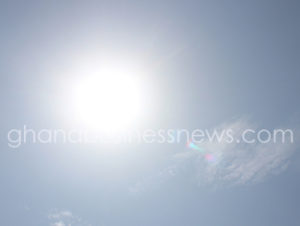Current atmospheric heat is caused by positioning of the sun – Meteo
 The increased atmospheric heat currently experienced in the country is because the sun has just crossed the equator into the northern hemisphere.
The increased atmospheric heat currently experienced in the country is because the sun has just crossed the equator into the northern hemisphere.
This means the sun has gotten very close to us, resulting in the extreme heat that is currently being experienced.
Mr. Michael Padi, Senior Meteorologist at the Ghana Meteorological Agency (GMA), told the Ghana News Agency that the extreme heating would lead to more evaporation, high atmospheric humidity, high temperatures and a lot of sweating.
He said it would ultimately result in cloud formation and rainfall that would typically be accompanied by thunderstorms.
“The extreme heat conditions would continue until the month of June when the Sun would be at its northern most position around the tropic of cancer, quite away from us,” Mr. Padi said.
He said the country would experience the lowest of temperatures in August, as a result of the position of the Sun then.
With the rainy season close at hand, a number of safety measures have been recommended to the public by the GMA.
People living in flood prone areas are advised to relocate to safer places and take every other precaution possible, while both drivers and pedestrians have also been urged not to force their way through floods, in order to avoid being swept away.
Mrs Francesca Martey, Deputy Director for Research, Ghana Meteorological Agency (GMA), gave the advice when she presented the agency’s seasonal forecast over Ghana, for 2019’s major rainy season.
She gave a breakdown of the expected period for the start of the rainy season and said the rains were estimated to begin between the fourth week of March and the second week of April for the East Coast.
That for Cape Coast/Saltpond will occur between the second and fourth week of March, the West Coast between the fourth week of February and the second week of March and the Forest Zone between the first and third week of March.
The rest are; between the fourth week of March and the second week of April for the country’s Transitional Zone area, the second and fourth week of April for the North, between the fourth week of April and the second week of May for the Upper East region and the third week of April to the first week of May for the Upper West region.
She said there was a high possibility of having rains accompanied by strong winds and lightning, which could cause localised floods.
Mrs Martey said there was thus the need for stakeholders, especially those directly concerned with disaster management, to educate the citizenry on the potential dangers of the pending season.
She said preparation also had to be made towards addressing negative effects of the season such as flooding.
Source: GNA
